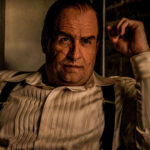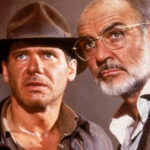

“Killers of the Flower Moon”, the latest project from renowned director Martin Scorsese, is a captivating dive into suspense and historical intrigue. Based on the best-selling book by David Grann, the film is set in the 1920s and explores one of the darkest and most mysterious cases in U.S. history.
The plot revolves around the murders of Osage tribe members, whose mysterious deaths trigger an investigation that uncovers a web of corruption and greed. The film not only delves into a grim chapter of American history but also highlights the complexity of human relationships and the devastating consequences of avarice.
With a star-studded cast and an engaging narrative, “Killers of the Flower Moon” promises to captivate audiences and provoke deep reflection on justice and morality.
1 – BASED ON TRUE EVENTS
Set around a century ago, “Killers of the Flower Moon” immerses viewers in a story based on real events that shocked the world. The film depicts the brutal massacre of the Osage people in Oklahoma, which occurred when their lands were discovered to be rich in oil.
The greed of local authorities led to a series of systematic murders, resulting in the deaths of around 20 people, with estimates suggesting that more than 100 might have been victims related to the oil-rich lands. The story follows the investigation led by an agent of the BOI—later to become the FBI—to uncover the truth behind these horrific crimes. With a tense narrative and a plot based on historical facts, the film offers a powerful reflection on corruption, justice, and the quest for truth.
2 – RESPECT FOR THE OSAGE COMMUNITY
Based on true events, “Killers of the Flower Moon” offers a sensitive and careful recreation of the tragic history of the Osage massacre. Directed by Martin Scorsese and co-written by him and Eric Roth, the film is an adaptation of David Grann’s book and was developed with the utmost respect for the Osage community.
Scorsese actively sought the involvement of Osage leaders to avoid negative stereotypes and ensure a fair representation of Native Americans. In an interview with Variety, actress Lily Gladstone highlighted that the collaboration with the indigenous community transformed the project, resulting in a more authentic and respectful work.
The film not only depicts a dark chapter in history but also reflects the importance of the voice and perspective of those involved in the narrative.
3 – SCORSESE, DE NIRO, AND DICAPRIO TOGETHER
In addition to new stars like Lily Gladstone and John Lithgow, the film marks the return of several of Scorsese’s regular collaborators. This is the seventh project that brings Martin Scorsese and Leonardo DiCaprio together and the eleventh with Robert De Niro (including the 2015 short film directed by Scorsese, “The Audition”).
Interestingly, this is the first time Scorsese, De Niro, and DiCaprio are working together on the same film, despite De Niro being the one who introduced DiCaprio to the director. Another returning actor is Jesse Plemons, who had previously appeared in Scorsese’s last film, “The Irishman”.
4 – LEONARDO DICAPRIO WOULD HAVE PLAYED ANOTHER CHARACTER
Initially, Leonardo DiCaprio was set to play Tom White, an FBI agent sent by J. Edgar Hoover to investigate the Osage tribe murders. However, DiCaprio felt it would be inappropriate to tell the story from the perspective of a white man and requested that the script be altered.
As a result, DiCaprio took on the role of Ernest Burkhart, the nephew of a powerful local businessman. Ernest is married to Mollie, a Native American woman, and witnesses the violence against her people. The role of Tom White eventually went to Jesse Plemons, known for his roles in “Game Night” and “The Power of the Dog.”
5 – LILY GLADSTONE
One of the film’s standout performances is by Lily Gladstone, an actress of Native American descent, who plays Mollie Burkhart, a Native American woman married to Ernest Burkhart, witnessing her people being devastated by white greed. However, few people know that Gladstone almost left her acting career.
Gladstone was about to enroll in a data logistics analysis course when she received an invitation for a meeting with Scorsese. The director was immediately impressed with her during the script reading, and shortly after, Gladstone was cast in the role of Mollie.
6 – THE FILM WAS AFFECTED BY THE PANDEMIC
One of the boldest projects of Martin Scorsese’s career, the film faced several changes due to the COVID-19 pandemic. Initially, filming was scheduled to begin in February 2019, but for unspecified reasons, the start of production was postponed to 2020, being directly impacted by the pandemic.
The project remained “on hold” for a long period until, in 2021, the first behind-the-scenes and production images began to emerge. The wait was rewarded as Scorsese and his team were able to further refine the narrative.
7 – MORE THAN CAPABLE CINEMATOGRAPHY
“Killers of the Flower Moon” also marks the return of a long-standing partnership for Martin Scorsese. The film’s director of photography is Rodrigo Prieto, the talented Mexican artist who has collaborated on several of the director’s works, including “The Wolf of Wall Street”, “The Irishman”, and “Silence”—for the latter two, he was nominated for an Academy Award for Best Cinematography.
Additionally, Prieto was involved in one of the year’s biggest successes, serving as the director of photography for “Barbie”, Greta Gerwig’s film about the iconic doll. Prieto has also worked with renowned directors such as Pedro Almodóvar, Ang Lee, and Alejandro González Iñárritu.
8 – SCORSESE LOVES MAKING LONG FILMS
The film has a confirmed runtime of 206 minutes—3 hours and 26 minutes—making it one of the longest films of Martin Scorsese’s career. However, it is still not the longest among his works.
While “The Irishman” surpasses “Killers of the Flower Moon” by two minutes, other Scorsese documentaries are also quite lengthy. Examples include “Bob Dylan: No Direction Home” (208 minutes), “A Personal Journey With Martin Scorsese Through American Movies” (225 minutes) and “My Voyage to Italy” (246 minutes).
9 – SCORSESE’S MOST EXPENSIVE FILM
“Killers of the Flower Moon” has an estimated budget of around $200 million, making it one of the most expensive films in history. This amount exceeds the cost of Scorsese’s last film, “The Irishman”, which cost approximately $159 million, making it the most expensive film of the director’s career.
Given Scorsese’s reputation for detail and preference for filming in authentic locations and stunning landscapes, the film combined the director’s technical excellence with an intense, mysterious, and deeply realistic narrative.
Unfortunately, the film was a box office failure, earning only $157 million.
10 – IGNORED BY THE OSCARS
The film was nominated for 10 Oscars, including Best Actress, Best Original Song, Best Costume Design, Best Supporting Actor, Best Picture, and others.
This is the third Scorsese film to receive more than 10 Oscar nominations and leave empty-handed.
“Catch Me If You Can” (2002) received 11 nominations, and “The Irishman” received 10 nominations, with both films failing to win any awards.
“Killers of the Flower Moon” not only reaffirms Martin Scorsese’s mastery as a filmmaker but also offers a deep dive into the history and culture of Native Americans, revealing a rich and complex narrative. With an impressive budget and epic runtime, the film stands out among the director’s most ambitious productions.
Scorsese’s collaboration with Leonardo DiCaprio and Robert De Niro, along with the introduction of new talent like Gladstone, marks a significant moment in the director’s filmography. By exploring themes of greed and injustice, “Killers of the Flower Moon” provokes important reflections on history and the human condition.








